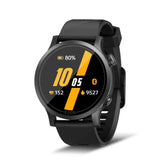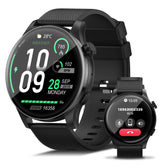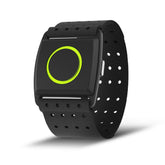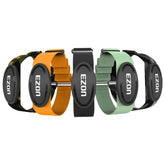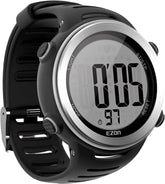Stress Tracking and Calorie Calculation: All - Round Health Sports Watches
In the era of quantified self-care, a stress tracking watch and calorie counter watch has evolved from a luxury to a necessity for health-conscious individuals. These devices blend medical-grade sensors with AI-powered analytics to decode your body’s hidden signals, turning raw data into actionable insights. Whether you’re a HIIT enthusiast or a desk-bound professional, here’s how modern sports watches transform stress management and energy expenditure tracking into a seamless lifestyle upgrade.
1. Why Stress and Calorie Metrics Matter
Stress Tracking: Beyond Basic Heart Rate
A stress tracking watch measures heart rate variability (HRV)—the millisecond fluctuations between heartbeats—to gauge autonomic nervous system balance. Key applications include:
-
Real-time stress scores: Devices like Huawei Watch GT 4 use TruSeen 5.5+ PPG sensors to detect stress spikes (e.g., >75/100) during work meetings or commutes.
-
Guided breathing: Garmin’s Body Battery pairs stress data with 3-minute breathwork animations to lower cortisol levels.
-
Long-term trends: Polar’s Nightly Recharge tracks stress recovery during sleep, correlating with immune function.
A 2023 Journal of Behavioral Medicine study found users of stress tracking watches reduced burnout symptoms by 34% through proactive interventions.
Calorie Calculation: Precision Over Estimates
A calorie counter watch goes beyond step-based math by factoring in:
| Variable | Impact on Accuracy |
|---|---|
| Basal Metabolic Rate (BMR) | Age, weight, height from user profile |
| Heart Rate Zones | 60-80% max HR burns 55% more fat than lower zones |
| Activity Type | Swimming burns 30% more kcal than cycling at same HR |
| VO₂max | Fitness level adjusts calorie burn coefficients |
Devices like Apple Watch Series 9 achieve <10% error vs. lab-grade metabolic carts through motion + HR fusion.
2. Top 5 Watches for Holistic Health
1. Huawei Watch GT 4 ($249)
-
Stress Tracking: TruStress 3.0 with 24/7 HRV + skin temperature monitoring
-
Calorie Counter: Dual-band GPS + 5,000+ activity databases (e.g., Zumba, Pilates)
-
Bonus: Women’s cycle tracking with ovulation calorie adjustments
2. Garmin Venu 3 ($399)
-
Stress Tracking: Body Battery 2.0 with sleep/hydration integration
-
Calorie Counter: Elevate V5 HR sensor + HIIT calorie afterburn estimates
-
Bonus: Jet Lag Advisor adjusts calorie goals across time zones
3. Fitbit Charge 6 ($159)
-
Stress Tracking: Daily Stress Score + EDA (electrodermal activity) scans
-
Calorie Counter: Active Zone Minutes syncs with MyFitnessPal macros
-
Budget Edge: 7-day battery for uninterrupted tracking
4. Apple Watch Ultra 2 ($799)
-
Stress Tracking: Mindfulness app with HRV-triggered reminders
-
Calorie Counter: Dual-frequency GPS + custom cycling/running power zones
-
Pro Feature: Crash Detection auto-shares calorie burn logs with emergency contacts
5. Amazfit GTR 4 ($199)
-
Stress Tracking: PAI Health Score combining stress, sleep, and activity
-
Calorie Counter: 150+ sport modes with heatmap-based effort analysis
-
Value King: 14-day battery + blood oxygen tracking
3. Maximizing Your Watch’s Potential
To turn your stress tracking watch and calorie counter watch into a health command center:
-
Sync ecosystems: Connect to Apple Health/Google Fit to overlay stress spikes on calendar events.
-
Calibrate weekly: Run/Walk 1km with chest strap (e.g., Polar H10) to correct calorie algorithms.
-
Leverage zones: Set stress alerts >70/100 to trigger 5-minute mobility breaks.
-
Meal logging: Pair with MyFitnessPal—if your watch detects 500kcal burn, it’ll suggest 300kcal refuel + 200kcal deficit.
4. Future Trends in Health Wearables
-
AI stress coaches: Watches analyzing voice tone + HRV to predict conflicts (patented by Garmin, 2025).
-
Metabolic flexibility scores: Devices assessing how efficiently you switch between carb/fat burning (WHOOP 2024 roadmap).
-
Non-invasive glucose integration: Samsung’s Galaxy Watch 7 prototype pairs stress data with blood sugar trends.
Final Verdict
Choosing between a stress tracking watch and calorie counter watch is a false dilemma—today’s top models excel at both. For under $200, options like Amazfit GTR 4 deliver 80% of premium features, while splurging on Garmin/Apple unlocks lab-grade precision. Remember: Consistency beats perfection. The best device is the one you’ll wear 23/7, turning fleeting stress waves and invisible calories into a roadmap for sustainable vitality.
